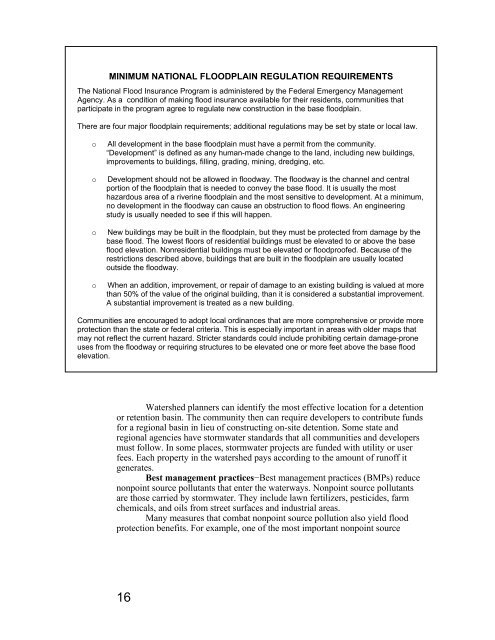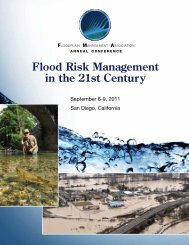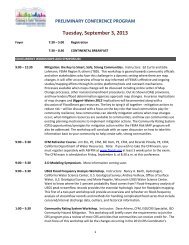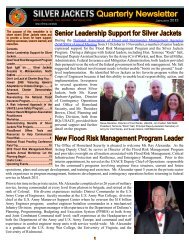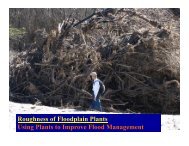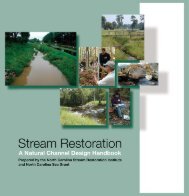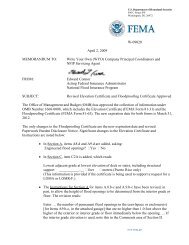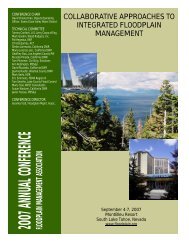Using Multi-Objective Management to Reduce Flood Losses in Your
Using Multi-Objective Management to Reduce Flood Losses in Your
Using Multi-Objective Management to Reduce Flood Losses in Your
Create successful ePaper yourself
Turn your PDF publications into a flip-book with our unique Google optimized e-Paper software.
MINIMUM NATIONAL FLOODPLAIN REGULATION REQUIREMENTS<br />
The National <strong>Flood</strong> Insurance Program is adm<strong>in</strong>istered by the Federal Emergency <strong>Management</strong><br />
Agency. As a condition of mak<strong>in</strong>g flood <strong>in</strong>surance available for their residents, communities that<br />
participate <strong>in</strong> the program agree <strong>to</strong> regulate new construction <strong>in</strong> the base floodpla<strong>in</strong>.<br />
There are four major floodpla<strong>in</strong> requirements; additional regulations may be set by state or local law.<br />
o<br />
o<br />
o<br />
o<br />
All development <strong>in</strong> the base floodpla<strong>in</strong> must have a permit from the community.<br />
“Development” is def<strong>in</strong>ed as any human-made change <strong>to</strong> the land, <strong>in</strong>clud<strong>in</strong>g new build<strong>in</strong>gs,<br />
improvements <strong>to</strong> build<strong>in</strong>gs, fill<strong>in</strong>g, grad<strong>in</strong>g, m<strong>in</strong><strong>in</strong>g, dredg<strong>in</strong>g, etc.<br />
Development should not be allowed <strong>in</strong> floodway. The floodway is the channel and central<br />
portion of the floodpla<strong>in</strong> that is needed <strong>to</strong> convey the base flood. It is usually the most<br />
hazardous area of a river<strong>in</strong>e floodpla<strong>in</strong> and the most sensitive <strong>to</strong> development. At a m<strong>in</strong>imum,<br />
no development <strong>in</strong> the floodway can cause an obstruction <strong>to</strong> flood flows. An eng<strong>in</strong>eer<strong>in</strong>g<br />
study is usually needed <strong>to</strong> see if this will happen.<br />
New build<strong>in</strong>gs may be built <strong>in</strong> the floodpla<strong>in</strong>, but they must be protected from damage by the<br />
base flood. The lowest floors of residential build<strong>in</strong>gs must be elevated <strong>to</strong> or above the base<br />
flood elevation. Nonresidential build<strong>in</strong>gs must be elevated or floodproofed. Because of the<br />
restrictions described above, build<strong>in</strong>gs that are built <strong>in</strong> the floodpla<strong>in</strong> are usually located<br />
outside the floodway.<br />
When an addition, improvement, or repair of damage <strong>to</strong> an exist<strong>in</strong>g build<strong>in</strong>g is valued at more<br />
than 50% of the value of the orig<strong>in</strong>al build<strong>in</strong>g, than it is considered a substantial improvement.<br />
A substantial improvement is treated as a new build<strong>in</strong>g.<br />
Communities are encouraged <strong>to</strong> adopt local ord<strong>in</strong>ances that are more comprehensive or provide more<br />
protection than the state or federal criteria. This is especially important <strong>in</strong> areas with older maps that<br />
may not reflect the current hazard. Stricter standards could <strong>in</strong>clude prohibit<strong>in</strong>g certa<strong>in</strong> damage-prone<br />
uses from the floodway or requir<strong>in</strong>g structures <strong>to</strong> be elevated one or more feet above the base flood<br />
elevation.<br />
Watershed planners can identify the most effective location for a detention<br />
or retention bas<strong>in</strong>. The community then can require developers <strong>to</strong> contribute funds<br />
for a regional bas<strong>in</strong> <strong>in</strong> lieu of construct<strong>in</strong>g on-site detention. Some state and<br />
regional agencies have s<strong>to</strong>rmwater standards that all communities and developers<br />
must follow. In some places, s<strong>to</strong>rmwater projects are funded with utility or user<br />
fees. Each property <strong>in</strong> the watershed pays accord<strong>in</strong>g <strong>to</strong> the amount of runoff it<br />
generates.<br />
Best management practices−Best management practices (BMPs) reduce<br />
nonpo<strong>in</strong>t source pollutants that enter the waterways. Nonpo<strong>in</strong>t source pollutants<br />
are those carried by s<strong>to</strong>rmwater. They <strong>in</strong>clude lawn fertilizers, pesticides, farm<br />
chemicals, and oils from street surfaces and <strong>in</strong>dustrial areas.<br />
Many measures that combat nonpo<strong>in</strong>t source pollution also yield flood<br />
protection benefits. For example, one of the most important nonpo<strong>in</strong>t source<br />
16


